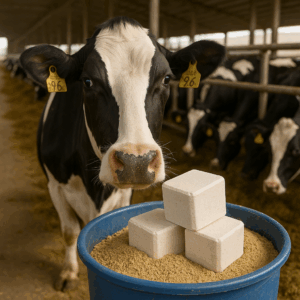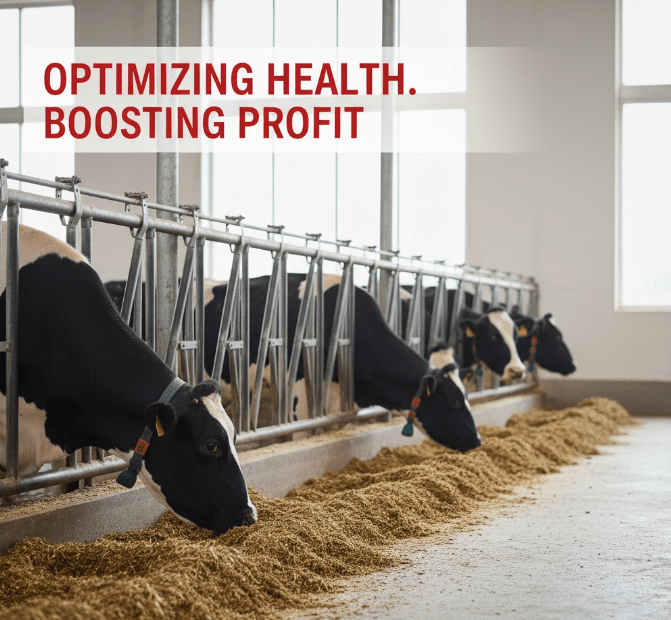Every fresh cow represents both an opportunity and a risk. Poor energy balance in early lactation often leads to costly metabolic disorders—ketosis, displaced abomasum, fatty liver—that compromise profitability and sustainability. Calcium salts of fatty acids do exactly that, providing rumen-protected energy that stabilizes fresh cow health and ensures long-term dairy sustainability.
Introduction: The Hidden Cost of Metabolic Disorders
Metabolic diseases silently drain profits from mid-to-large dairies. Studies show that ketosis can reduce milk yield by up to 3 kg/day, while displaced abomasum costs producers $250–400 per case. In a 500+ cow herd, these losses accumulate rapidly.
Calcium salts of fatty acids offer a sustainable, research-backed strategy to support energy balance, reduce metabolic stress, and drive profitability.
Section 1: Why Fresh Cows Struggle with Energy
- Dry matter intake lag: Early lactation cows cannot physically consume enough feed to meet their energy requirements.
- Body fat mobilization: NEB leads to non-esterified fatty acids (NEFA) flooding the liver, increasing ketosis risk.
- Hormonal shifts: Glucose demand for lactation outpaces supply, impairing immunity and reproduction.
Nutritionists must bridge this gap without overloading the rumen.
Section 2: Calcium Salts as a Metabolic Safety Net
Unlike unprotected fats, calcium salts bypass the rumen and release energy in the small intestine. Benefits include:
- Controlled energy release reduces liver fat accumulation.
- Lower ketone production supports faster recovery post-calving.
- Improved immune resilience, reducing secondary infections like metritis or mastitis.
Section 3: Impact on Key Disorders
- Ketosis
- Supplementing calcium salts reduces NEFA mobilization.
- Trials show a 30% decrease in subclinical ketosis incidence with fat supplementation (University of Florida IFAS).
- Fatty Liver
- By sparing the liver from excess fat processing, calcium salts lower hepatic triglyceride accumulation.
- Cows transition smoother, with better reproductive performance.
- Displaced Abomasum (DA)
- Reduced energy deficits mean fewer down cows, less fat infiltration, and improved rumen fill.
- Calcium salts indirectly lower DA risk by stabilizing appetite and gut motility.

Section 4: Herd Health and Sustainability
Healthy cows are sustainable cows. Calcium salts support:
- Lower culling rates – saving $1,200–$1,800 per replacement heifer.
- Higher reproductive efficiency – fewer days open reduce environmental impact per liter of milk.
- Antibiotic stewardship – less disease translates to reduced antibiotic use, aligning with consumer and regulatory pressures.
For more sustainability-focused strategies, see our Dairy Solutions Hub.
Section 5: Practical Feeding Guidelines
- Inclusion rate: 3–5% of dietary DM.
- Blends:
- Palmitic acid (C16:0): Boosts milk fat, stabilizes NEB.
- Oleic acid (C18:1): Improves digestibility and energy partitioning.
- Stage focus: Especially critical in transition diets (3 weeks pre- to 6 weeks post-calving).
Section 6: ROI in Preventing Disorders
- Average ketosis case costs ~$289 (direct + lost production).
- DA adds ~$400 per case.
- A 500-cow herd with 15% ketosis prevalence loses >$20,000 annually.
Calcium salts that reduce incidence by even 30% generate savings that far outweigh additive costs.
Section 7: Case Studies
- University of Wisconsin: Cows supplemented with CaFA had lower plasma NEFA and BHBA levels, directly linked to reduced ketosis.
- European Trials (WUR): Transition diets with CaFA decreased liver fat accumulation and improved fertility by 15%.
Section 8: Sustainability & Consumer Confidence
Dairies today face consumer and regulatory scrutiny on antibiotic use and cow health outcomes. Calcium salts support:
- Transparent sustainability metrics.
- Healthier cows that produce more milk with fewer inputs.
- Alignment with ESG goals in North American and European markets.

Section 9: Buyer Considerations
Are calcium salts consistent across suppliers?
- Quality varies—rely on trusted sources like Valudor or Megalac for uniform blends.
Will calcium salts replace starch energy?
- No, they complement starch by supplying safe, high-density energy.
Is this strategy long-term sustainable?
- Yes—lower metabolic stress reduces replacement rates and aligns with herd longevity goals.
Section 10: Implementing Calcium Salt Programs
- Audit fresh cow disorders (ketosis prevalence, DA rates).
- Calculate ROI using herd health and milk yield data.
- Integrate with total mixed ration (TMR) balancing to avoid over-supplementation.
- Track KPIs: NEFA, BHBA, milk yield, and reproduction outcomes.
Conclusion
Calcium salts of fatty acids are not just a productivity tool—they are a preventive health investment. By reducing the risk of metabolic disorders, nutritionists can secure profitability, improve sustainability, and enhance consumer trust in dairy products.
References (Authoritative, Non-Competitor Sources)
- Drackley, J.K. (1999). Biology of dairy cows during the transition period: the final frontier? Journal of Dairy Science.
- University of Florida IFAS Extension – Feeding Fat to Dairy Cows. https://edis.ifas.ufl.edu
- Wageningen University & Research – Transition cow nutrition research. https://www.wur.nl
- McArt, J.A.A., Nydam, D.V., Oetzel, G.R. (2012). Epidemiology of subclinical ketosis in early lactation dairy cattle. Journal of Dairy Science.
- Overton, T.R., McArt, J.A.A. (2015). Managing transition cow disorders. Veterinary Clinics: Food Animal Practice.
Protect your herd from costly metabolic disorders while driving milk yield gains. Discover how our nutrition solutions can help your dairy achieve sustainable health and profitability. Connect with us today.
